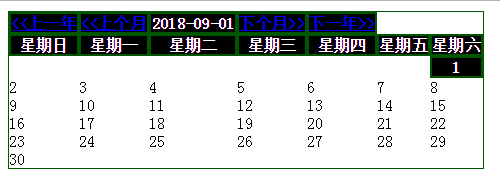本文实例讲述了PHP实现的日历功能。分享给大家供大家参考,具体如下:
<?php/* * Created by PhpStorm. * User: admin */header("Content-Type:text/html;charset=utf-8");date_default_timezone_set("PRC");$a=@$_GET["a"];$b=@$_GET["b"];if($a){ $a=$a;}else{ $a=date('y');}if($b){ $b=$b;}else{ $b=date('m');}$noe=mktime(0,0,0,$b,1,$a); //获取当前的月的一号$year=date("Y",$noe); //当前的年$month=date("m",$noe); //当前的月$week=date("w",$noe); // 每个月的一号是星期几$days=date("t",$noe); //每个月的总天数$day=date("d"); //获取今天是几号$as=$year-1; //获取上一年的年$bs=$month-1; //获取上个月$bs=$month+1; // 获取下个月$as=$year+1; //获取下一年?><!doctype html><html lang="en"><head> <meta charset="UTF-8"> <title>日历</title> <style> table{ border: 1px solid #050; } table th{ background:#000; color:#fff; border: 2px solid #050; } </style></head><body> <table cellpadding="0" cellspacing="0"> <tr> <th><a href="?a=<?php echo $as; ?>" rel="external nofollow" rel="external nofollow" ><<上一年</a></th> <th><a href="?b=<?php echo $bs; ?>" rel="external nofollow" rel="external nofollow" ><<上个月</a></th> <th><?php echo $year."-".$month."-".$day ?></th> <th><a href="?b=<?php echo $bs; ?>" rel="external nofollow" rel="external nofollow" >下个月>></a></th> <th><a href="?a=<?php echo $as; ?>" rel="external nofollow" rel="external nofollow" >下一年>></a></th> </tr> <tr> <th>星期日</th> <th>星期一</th> <th>星期二</th> <th>星期三</th> <th>星期四</th> <th>星期五</th> <th>星期六</th> </tr> <tr> <?php for($i=0;$i<$week;$i++){ echo "<td> </td>"; //获取当月一号前面的空格 } for($k=1;$k<=$days;$k++){ if($k==$day){ echo "<th>".$k."</th>"; //输出今天是几号 }else{ echo "<td>".$k."</td>"; //输出当月天数 } if(($k+$week)%7==0){ echo "<tr></tr>"; // 一周七天换行 } } ?> </tr> </table></body></html>运行结果:

PS:这里再为大家推荐几款时间及日期相关工具供大家参考:
在线日期/天数计算器:
http://tools.jb51.net/jisuanqi/date_jisuanqi
在线日期计算器/相差天数计算器:
新闻热点
疑难解答